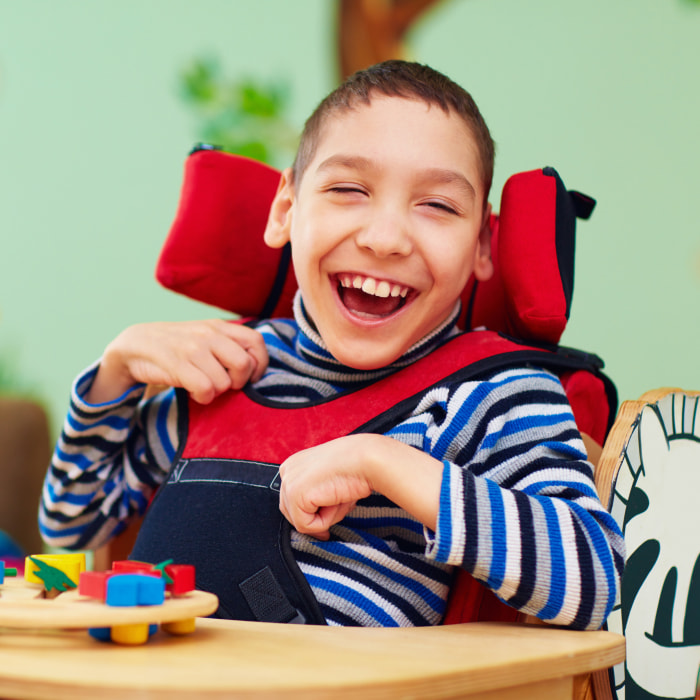Skip to content

Bullying is aggressive behavior that targets individuals, causing harm and distress. When children with special needs experience bullying, it can be especially heartbreaking. It also presents unique challenges for parents and teachers of children who often struggle to communicate. Understanding the serious impact of bullying and recognizing warning signs is crucial. By working together, parents, caregivers, and educators can prevent bullying and create a safe, inclusive environment where every child can thrive.

Understanding bullying
Bullying refers to the repeated, intentional mistreatment of individuals. It can take various forms — such as physical aggression, verbal abuse, or online harassment — and often involves an imbalance of power between the bully and the victim.
Children with special needs are often targeted due to their differences, such as physical disabilities, communication challenges, or social interactions.
Types of bullying
There are various types of bullying. By understanding these different forms of intimidation, parents, caregivers, and educators will be better able to spot and stop bullying.
Here are 6 common types of bullying:
Physical bullying: This includes kicking, hitting, biting, pinching, and hair pulling, which can be especially harmful.
Verbal bullying: Name-calling, spreading rumors, persistent teasing, and making threats are common forms of verbal bullying that can deeply affect children.
Emotional intimidation: Deliberate exclusion from group activities, such as parties or school outings, can cause emotional distress.
Racist bullying: Making racial slurs, mocking cultural customs, and engaging in offensive gestures can create a hostile environment.
Sexual bullying: Unwanted physical contact or abusive comments can cause significant emotional harm.
Cyberbullying: This involves threatening, harassing, or humiliating another child or teen through electronic means like computers or cell phones.

What is the impact of bullying victimization on mental health?
Bullying can significantly impact the mental health of children with special needs. It can lead to increased anxiety, depression, loneliness, low self-esteem, and difficulties with social interactions.
Bullying and children with special needs
Children with special needs are targeted by bullies due to factors like physical vulnerability, social skill challenges, and intolerant environments.
Here are some common disabilities and their related symptoms that could make children with special health care needs targets of bullies.
Condition(s) Common symptoms
Autism Spectrum Disorder (ASD), Attention Deficit Hyperactivity Disorder (ADHD), and Tourette syndrome (TS)
Trouble with social interactions, acute sensitivities, impulsivity, and lack of self-regulation
Brain injuries
Impaired speech, movement disorders, and problems with comprehension and learning
Cerebral palsy, spina bifida, or other neurological or physical conditions
Challenges with physical coordination and speech
Epilepsy
Unusual behavior that makes them stand out from others
Mental health conditions
Appearing shy, reserved, apprehensive, worried, or vulnerable
Warning signs of bullying special needs children
Children with certain conditions like brain damage or neurological disorders can have a difficult time understanding social interactions.
 Remember, if your child struggles to understand social interactions, they may also be unaware that they are being bullied.
Remember, if your child struggles to understand social interactions, they may also be unaware that they are being bullied.
This is why parents, caregivers, and educators must be especially vigilant and watch for warning signs.
Here are some warning signs that a child with special needs is being bullied:
Changes in behavior or mood
Decreased self-esteem or self-confidence
Difficulty making friends or maintaining relationships
Exclusion from social groups or activities
Increased anxiety or fear in social settings
Loss of interest in previously enjoyed activities
Sudden isolation or avoidance of social interactions
Unexplained physical injuries or marks
It is important to note that these signs can vary depending on the individual and their specific condition. Therefore, you should closely observe your child and communicate with them to understand their experiences.
Preventing bullying in your child with special needs
Preventing bullying is extremely important to ensure the well-being of children with special needs. By taking proactive steps and implementing strategies, parents and caregivers can create a safe and supportive environment that reduces the risk of bullying and promotes the child’s overall development and happiness.
What are the three R’s of bullying prevention?
Understanding the three R’s of bullying prevention is key to creating a safe and inclusive environment for children with special needs.
Here are the three R’s of bullying prevention:
Recognizing the signs of bullying, such as changes in behavior or unexplained injuries.
Responding by offering support, intervening appropriately, and teaching assertiveness skills.
Reporting incidents to trusted authorities to ensure that appropriate actions can be taken to address the issue and protect the well-being of all students.
10 tips to prevent bullying
Here are 10 tips to help you identify bullying and stop it from happening.
Keep a careful watch for signs of bullying and take action promptly.
Listen to your child, giving them an opportunity to openly communicate about their experiences.
Pay attention to changes in your child’s mood, which may indicate bullying-related stress.
Stay alert to self-destructive behaviors like running away or self-harm, and take immediate action if observed.
Monitor your child’s sleep patterns, as disrupted sleep can be a sign of bullying’s impact.
Talk with your child’s teachers right away if their academic performance declines unexpectedly.
Familiarize yourself with your child’s daily schedule to identify potential bullying situations.
Take note of any lost or damaged possessions that could have been stolen or vandalized by a bully.
Teach your child assertiveness skills to effectively respond to bullying situations.
Encourage healthy friendships and social connections to reduce vulnerability to bullying.
These tools can help you create a strong foundation against bullying and reinforce resilience in your child.
How educators can respond to bullying
Educators play a vital role in responding to bullying incidents. They can also take steps to prevent bullying from happening by fostering a safe and inclusive classroom environment.
Here are some ways educators can take charge:
Educate all students about empathy and respect for others
Implement effective behavior management strategies
Promote social skills development
Provide ongoing support to students who have experienced bullying
Tips for teachers: How do you include a child with special needs in the classroom? Talk with special education teachers at your school for guidance. Through their dedication and advocacy, these specially trained educators know how to create a nurturing and supportive school climate for all students.
Anti-bullying laws for special needs students
State laws play a vital role in addressing and preventing bullying in schools. Each state has its own approach, with specific laws, policies, and regulations or model policies that schools can adopt.
These laws require schools to have bullying policies, investigate bullying incidents, and take appropriate action.
Additionally, the U.S. Department of Education has built common components into state laws, such as clear definitions of bullying and requirements for school district policies.
What to do if your special needs child is being bullied
If your special needs child is being bullied, it is essential to take immediate action to protect them.
You can take action by:
Listening to your child’s concerns and validating their feelings.
Reporting the incidents to the appropriate school authorities.
Working with the school to develop a plan to address the bullying.
Supporting your child and ensuring their safety throughout the entire process.
While each case is different, you may be able to use interventions to stop bullying.
What interventions stop bullying?
Effective interventions to stop bullying include working with your child’s school to implement policies that promote a positive and inclusive environment. Schoolwide policies can help foster empathy and social skills among all students.
You can also work with school administrators and the other child’s parents to provide targeted support for both the victim and the bully.
By addressing the root causes and drawing upon appropriate resources, interventions to stop bullying can create a safer and more respectful climate, reducing the likelihood of bullying behaviors.
Bullying resources and support
Addressing bullying requires a collaborative effort involving parents, educators, and sometimes even mental health professionals.
Remember to seek help from service providers in your child’s school and know when to reach out for additional assistance.
You may wish to explore the following online resources:
DoSomething.org
Pacer’s National Bullying Prevention Center
Stomp Out Bullying
StopBullying.gov
These resources offer additional guidance, tools, and support to combat bullying and ensure the well-being of all children, including those with special needs.
Get Answers to Your Questions
Are there support groups for cerebral palsy?
What does cerebral palsy look like in adults?
How does cerebral palsy affect education?
Where can I get CP financial assistance?
Is there cerebral palsy help for parents?
What is it like living with cerebral palsy?
What’s the transition to adulthood like with CP?
Diagnosis and prognosis
Treatments and therapies
Financial support options
Cerebral Palsy Guide was founded upon the goal of educating families about cerebral palsy, raising awareness, and providing support for children, parents, and caregivers affected by the condition. Our easy-to-use website offers simple, straightforward information that provides families with medical and legal solutions. We are devoted to helping parents and children access the tools they need to live a life full of happiness
Amie Kroessig is a Patient Advocate and Outreach Coordinator for Cerebral Palsy Guide. In her role, she provides resources and support to families and caregivers of children with cerebral palsy to help give them the quality of life they deserve.
About Amie Kroessig
 As a Patient Advocate and Outreach Coordinator, one of Amie’s favorite things in her role is connecting with families to offer reassurance and guidance in the face of their child’s cerebral palsy diagnosis.
As a Patient Advocate and Outreach Coordinator, one of Amie’s favorite things in her role is connecting with families to offer reassurance and guidance in the face of their child’s cerebral palsy diagnosis.
When Amie was born with cerebral palsy, there were limited resources available. However, her adoptive parents were determined to provide her with every tool and therapy necessary for a fulfilling life.
Knowing that the information on Cerebral Palsy Guide could have greatly benefited her own parents, Amie is passionate about ensuring that ALL families and caregivers have this valuable resource at their fingertips.
Amie lives in St. Petersburg, Florida, where she enjoys going to the beach.




 Remember, if your child struggles to understand social interactions, they may also be unaware that they are being bullied.
Remember, if your child struggles to understand social interactions, they may also be unaware that they are being bullied. As a Patient Advocate and Outreach Coordinator, one of Amie’s favorite things in her role is connecting with families to offer reassurance and guidance in the face of their child’s cerebral palsy diagnosis.
As a Patient Advocate and Outreach Coordinator, one of Amie’s favorite things in her role is connecting with families to offer reassurance and guidance in the face of their child’s cerebral palsy diagnosis.